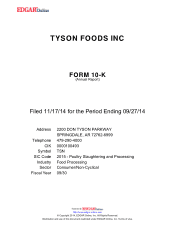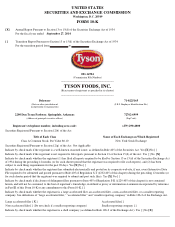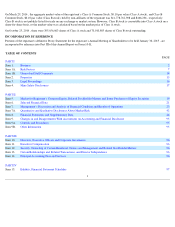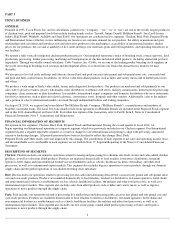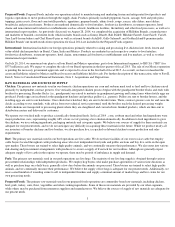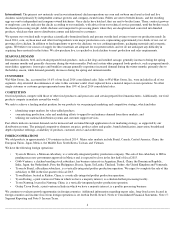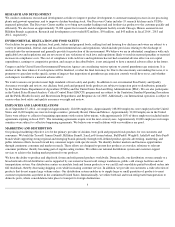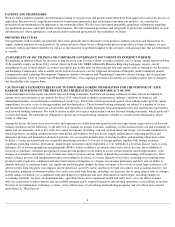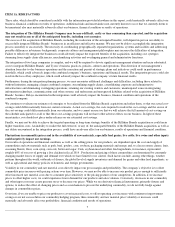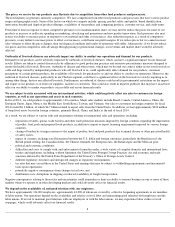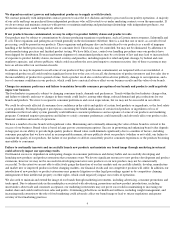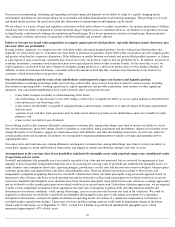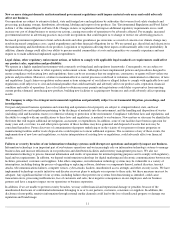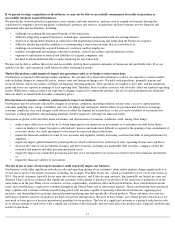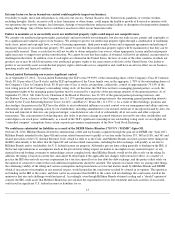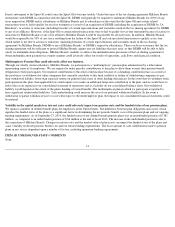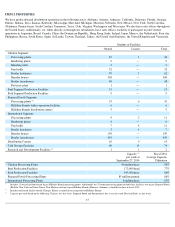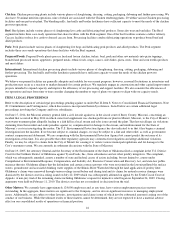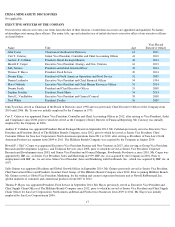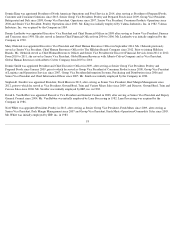Tyson Foods 2014 Annual Report Download - page 10
Download and view the complete annual report
Please find page 10 of the 2014 Tyson Foods annual report below. You can navigate through the pages in the report by either clicking on the pages listed below, or by using the keyword search tool below to find specific information within the annual report.
The prices we receive for our products may fluctuate due to competition from other food producers and processors.
The food industry in general is intensely competitive. We face competition from other food producers and processors that have various product
ranges and geographic reach. Some of the factors on which we compete include: pricing, product safety and quality, brand identification,
innovation, breadth and depth of product offerings, availability of our products and competing products, customer service, and credit terms.
From time to time in response to these competitive pressures or to maintain market share, we may need to reduce the prices for some of our
products or increase or reallocate spending on marketing, advertising and promotions and new product innovation. Such pressures also may
restrict our ability to increase prices in response to raw material and other cost increases. Any reduction in prices as a result of competitive
pressures, or any failure to increase prices to offset cost increases, could harm our profit margins. If we reduce prices but we cannot increase
sales volumes to offset the price changes, then our financial condition and results of operations will suffer. Alternatively, if we do not reduce
our prices and our competitors seek advantage through pricing or promotional changes, our revenues and market share would be adversely
affected.
Outbreaks of livestock diseases can adversely impact our ability to conduct our operations and demand for our products.
Demand for our products can be adversely impacted by outbreaks of livestock diseases, which can have a significant impact on our financial
results. Efforts are taken to control disease risks by adherence to good production practices and extensive precautionary measures designed to
ensure the health of livestock. However, outbreaks of disease and other events, which may be beyond our control, either in our own livestock or
cattle and hogs owned by independent producers who sell livestock to us, could significantly affect demand for our products, consumer
perceptions of certain protein products, the availability of livestock for purchase by us and our ability to conduct our operations. Moreover, the
outbreak of livestock diseases, particularly in our Chicken segment, could have a significant effect on the livestock we own by requiring us to,
among other things, destroy any affected livestock. Furthermore, an outbreak of disease could result in governmental restrictions on the import
and export of our products to or from our suppliers, facilities or customers. This could also result in negative publicity that may have an adverse
effect on our ability to market our products successfully and on our financial results.
We are subject to risks associated with our international activities, which could negatively affect our sales to customers in foreign
countries, as well as our operations and assets in such countries.
In fiscal 2014 , we sold products to approximately 130 countries. Major sales markets include Brazil, Canada, Central America, China, the
European Union, Japan, Mexico, the Middle East, South Korea, Taiwan, and Vietnam. Our sales to customers in foreign countries for fiscal
2014 totaled $6.3 billion, of which $4.7 billion related to export sales from the United States. In addition, we had approximately $324 million
of long-lived assets located in foreign countries, primarily Brazil, China, and India, at the end of fiscal 2014 .
As a result, we are subject to various risks and uncertainties relating to international sales and operations, including:
Negative consequences relating to these risks and uncertainties could jeopardize or limit our ability to transact business in one or more of those
markets where we operate or in other developing markets and could adversely affect our financial results.
We depend on the availability of, and good relations with, our employees.
We have approximately 124,000 employees, approximately 42,000 of whom are covered by collective bargaining agreements or are members
of labor unions. Our operations depend on the availability and relative costs of labor and maintaining good relations with employees and the
labor unions. If we fail to maintain good relations with our employees or with the labor unions, we may experience labor strikes or work
stoppages, which could adversely affect our financial results.
8
•
imposition of tariffs, quotas, trade barriers and other trade protection measures imposed by foreign countries regarding the importation
of poultry, beef, pork and prepared foods products, in addition to import or export licensing requirements imposed by various foreign
countries;
•
closing of borders by foreign countries to the import of poultry, beef and pork products due to animal disease or other perceived health
or safety issues;
•
impact of currency exchange rate fluctuations between the U.S. dollar and foreign currencies, particularly the Brazilian real, the
British pound sterling, the Canadian dollar, the Chinese renminbi, the European euro, the Indian rupee and the Mexican peso;
•
political and economic conditions;
•
difficulties and costs to comply with, and enforcement of remedies under, a wide variety of complex domestic and international laws,
treaties and regulations, including, without limitation, the United States Foreign Corrupt Practices Act and economic and trade
sanctions enforced by the United States Department of the Treasury’s Office of Foreign Assets Control;
•
different regulatory structures and unexpected changes in regulatory environments;
•
tax rates that may exceed those in the United States and earnings that may be subject to withholding requirements and incremental
taxes upon repatriation;
•
potentially negative consequences from changes in tax laws; and
•
distribution costs, disruptions in shipping or reduced availability of freight transportation.

